Physical Address
304 North Cardinal St.
Dorchester Center, MA 02124
The mitral valve apparatus is composed of the mitral annulus, leaflets, chordae tendineae, papillary muscles, and the left ventricular lateral wall ( Fig. 80-1 ). Chordae tendineae and papillary muscles comprise the subvalvular apparatus.
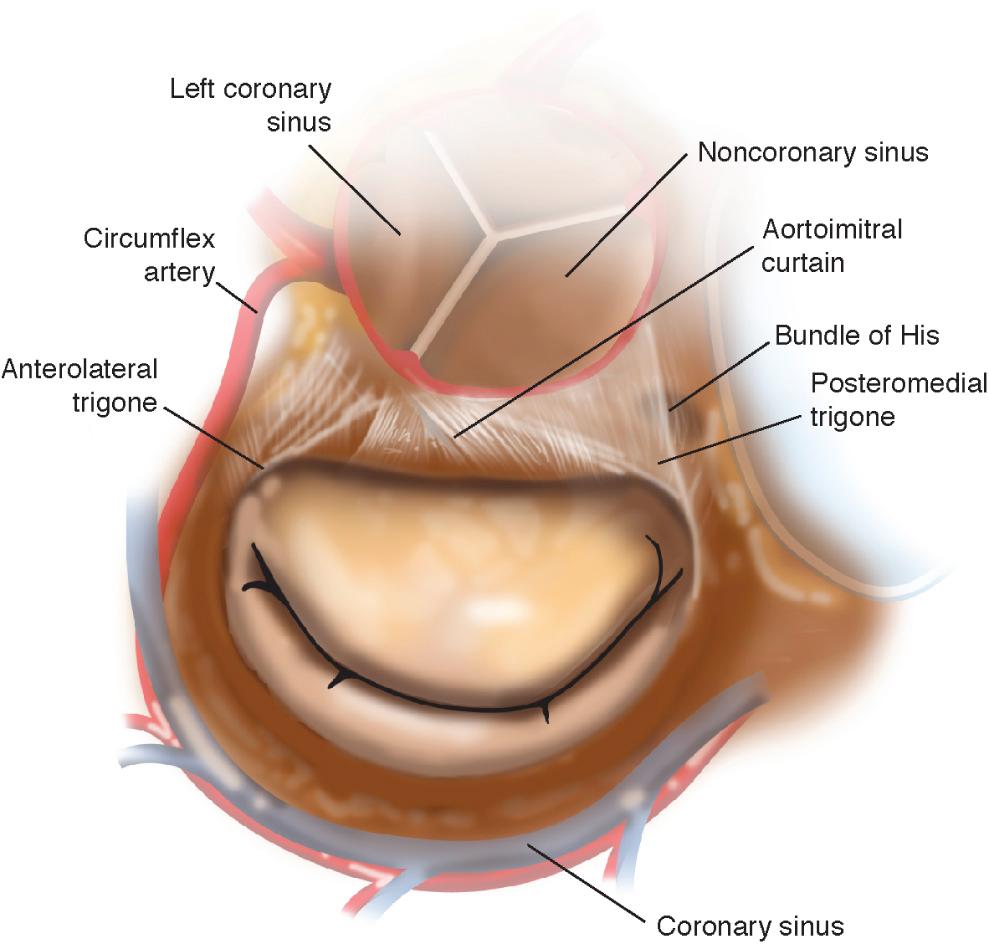
The right fibrous trigone is a dense fibrous area of continuity between the annuli of the mitral, tricuspid, and noncoronary cusp of the aortic valve, as well as the membranous interventricular septum. The left fibrous trigone forms the leftmost border of fibrous continuity between the aortic and mitral valves. The mitral valve leaflets are attached to an ovoid ring, or annulus of fibrous tissue, that extends from the right and left fibrous trigones to form the junction between the left atrium and ventricle. In three-dimensional space, the annulus maintains a hyperbolic paraboloid shape (saddle shape). The mid-anterior and mid-posterior annular segments are highest (farthest away from the ventricular apex), whereas the anterolateral and posteromedial commissures are lowest. The mitral annulus is thinnest at the insertion site of the posterior leaflet. As this segment is not attached to any rigid cardiac structures, it is the most mobile throughout the cardiac cycle and is the most prone to annular dilation.
The mitral valve has two major leaflets: the larger anterior (aortic) leaflet and the smaller posterior (mural) leaflet. The anterior leaflet is semicircular and is attached to one third of the annular circumference. The leaflet free edge does not have indentations. The anterior leaflet defines the boundary between the inflow and outflow tracts of the left ventricle. The posterior leaflet is quadrangular and is attached to two thirds of the annular circumference. The leaflet typically contains three or more scallops separated by fetal clefts or subcommissures, which develop to variable degrees in each individual.
The subcommissures of the posterior leaflet permit further division of the mitral valve into eight segments ( Fig. 80-2 ). The three posterior leaflet scallops are anatomically termed anterolateral (P1), middle (P2), and posteromedial (P3) segments. The three corresponding segments of the anterior leaflet are the anterior segment (A1), middle segment (A2), and posterior segment (A3). The anterolateral and posteromedial commissures comprise the remaining two segments. The posteromedial and anterolateral commissures are identified by the axis of the corresponding papillary muscles and the commissural chordae. The distance between the free edge of the commissures and the annulus is approximately 8 mm. As such, during open commissurotomy it is important to maintain this distance to reduce the risk of leaflet tearing and subsequent mitral regurgitation.
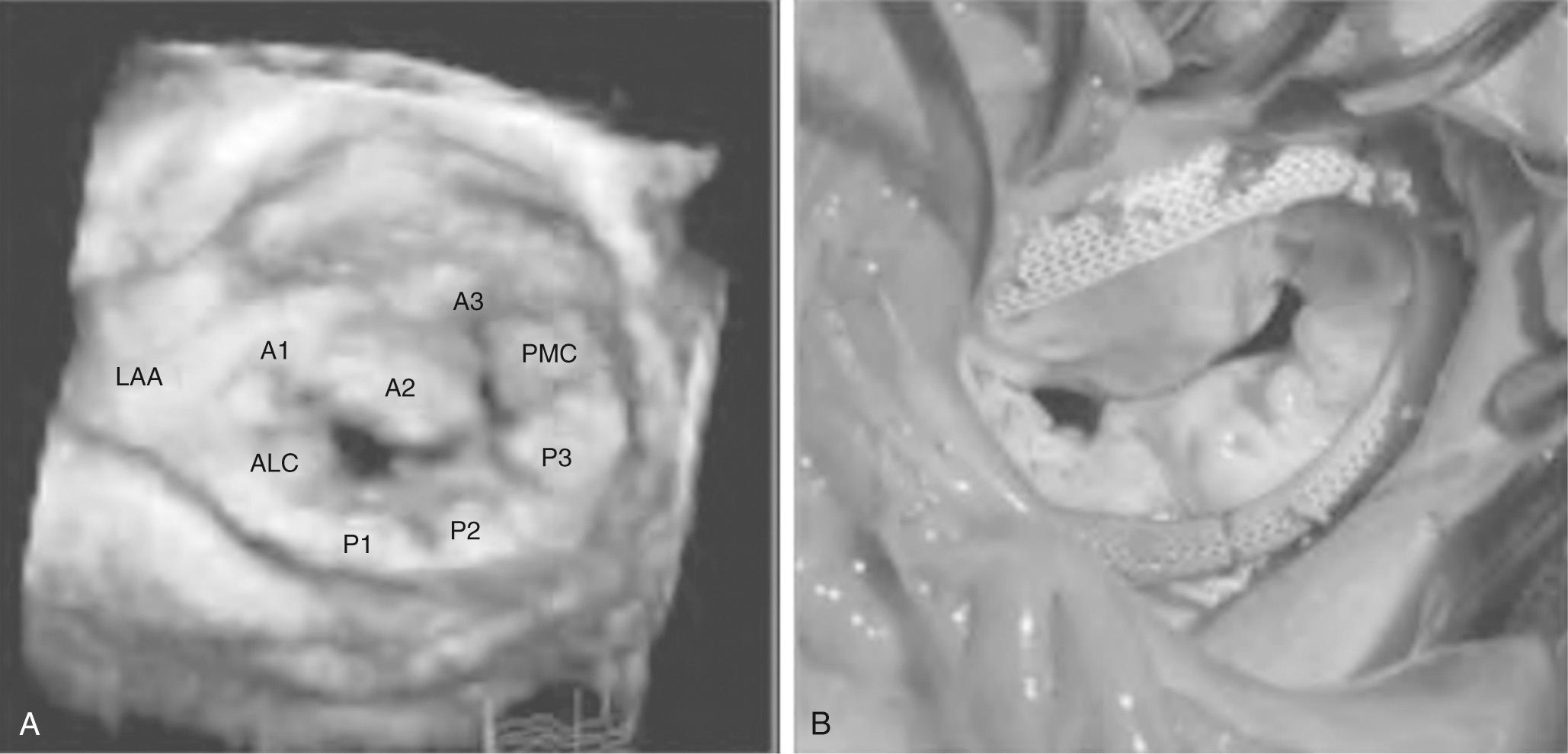
The atrial surface of the leaflets is divided into two zones: a marginal rough zone and central smooth zone. The rough zone is the coaptation surface of the valve and is the insertion site of most of the chordae tendineae.
The chordae tendineae are collagenous leaflet extensions connecting the papillary muscles and the ventricular side of the leaflets ( Fig. 80-3 ). Chordae are classified based on the site of insertion on the leaflet. Primary chordae insert on the leaflet free margin and act to prevent leaflet prolapse. Secondary chordae insert on the ventricular surface of the leaflets and reduce excess tension on the leaflet tissue. Tertiary chordae connect the leaflet base to the mitral annulus and surrounding myocardium. Tertiary chordae are limited to the posterior leaflet of the mitral valve. Often, the diameter of the chordae increases from the leaflet edge to the annulus.
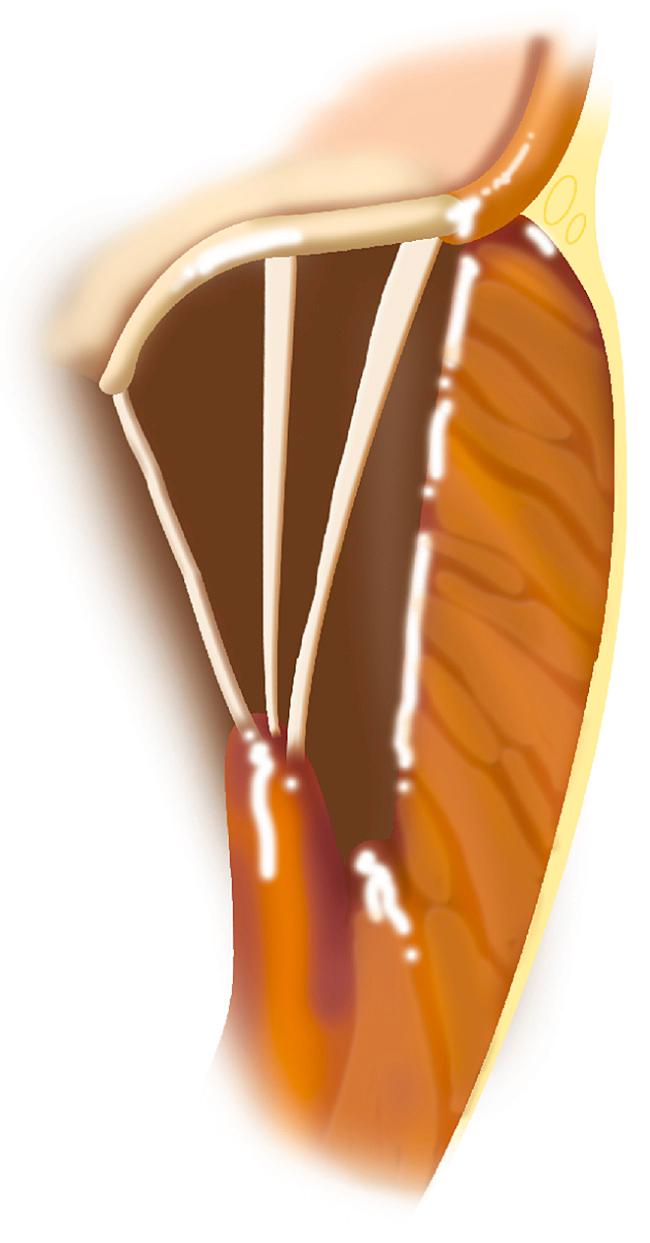
Two papillary muscles arise between the middle and apical thirds of the left ventricle. The anterolateral papillary muscle is typically composed of one muscle body while the posteromedial papillary muscle usually arises from two muscle bodies. Each papillary muscle supplies chordae to both leaflets. The anterolateral papillary muscle receives blood from both the left anterior descending artery as well as a diagonal or obtuse marginal branch of the circumflex artery. However, the posteromedial papillary muscle receives blood from only one source: either the circumflex or right coronary artery. Consequently, the posteromedial papillary muscle is more sensitive to myocardial ischemia than the anterolateral papillary muscle. As the lateral wall of the left ventricle supports the base of the papillary muscles, it may also be considered part of the mitral valve apparatus. In fact, the left ventricular lateral wall is integral in the pathogenesis of ischemic mitral regurgitation.
In non-diseased adult human hearts, the normal mitral valve area is 4 to 6 cm 2 . Once the mitral valve orifice narrows to less than 2.5 cm 2 , a pressure gradient is necessary to generate blood flow from the left atrium into the left ventricle. Based on a semi-quantitative grading system, mitral stenosis is typically classified as mild if the valve area is >1.5 cm 2 , moderate when the valve area is between 1.0 and 1.5 cm 2 , and severe when the valve area is <1.0 cm 2 or the mean transvalvular pressure gradient exceeds 10 mm Hg ( Table 80-1 ). However, it should be noted that the definition of severe mitral stenosis used by the American College of Cardiology/American Heart Association (ACC/AHA) is based on the severity at which symptoms occur as well as the severity at which intervention will improve symptoms (in essence, “severe” in professional society guidelines should be read as “significant”). Thus, in the 2014 iteration of the ACC/AHA guidelines, a mitral valve area of 1.5 cm 2 or less and a mean transvalvular gradient between 5 and 10 mm Hg is considered severe.
| Findings | Mild | Moderate | Severe |
|---|---|---|---|
| Specific | |||
| Valve area (cm 2 ) | >1.5 | 1.0-1.5 | <1.0 |
| Supportive | |||
| Mean gradient (mm Hg) * | <5 | 5-10 | >10 |
| Pulmonary artery pressure (mm Hg) | <30 | 30-50 | >50 |
* At heart rates between 60 and 80 beats/min and in sinus rhythm.
The transvalvular gradient results in elevated left atrial and pulmonary venous pressures. Over time, pulmonary artery hypertension develops from a combination of compensatory arterial vasoconstriction, intimal hypertrophy of the pulmonary arterioles and obliterative change, and passive retrograde transmission of the elevated pulmonary venous pressure. Pulmonary edema results when pulmonary venous pressure exceeds plasma oncotic pressure. At rest, mitral stenosis is often asymptomatic; however, any increase in flow across the mitral valve or decrease in duration of diastole results in an increase in the transvalvular pressure gradient. Consequently, dyspnea is typically precipitated by exercise, stress, infection, pregnancy, or rapid atrial fibrillation.
As pulmonary artery pressures rise, both right ventricular end-diastolic pressure and volume increase, resulting in right ventricular dilation and tricuspid regurgitation. Because left ventricular inflow is restricted, left ventricular chamber size or end-diastolic volume is normal or less than normal, and end-diastolic pressure is generally low. Although most patients with mitral stenosis have normal left ventricular dimensions and systolic function, ejection fraction is significantly reduced in a small proportion of patients (generally older adults). These patients often have severe segmental wall contraction abnormalities of the posterobasal or anterolateral segments likely from papillary muscle fibrosis and immobilization. Diffuse hypokinesis has also been described and is likely due to a chronic low cardiac output state.
Although the prevalence of rheumatic disease has markedly decreased in recent decades, particularly in developed nations, it remains the predominant cause of mitral stenosis in the United States and worldwide. However, only half to two thirds of patients report a definite history of rheumatic fever, with at least a 2:1 female-to-male predominance. Rheumatic valve disease is generally acquired before age 20, and becomes clinically evident one to three decades later. Nonrheumatic etiologies of mitral stenosis include severe mitral annular calcification (common in older people), congenital mitral valve deformities, carcinoid syndrome, systemic lupus, neoplasm, and prosthetic valve calcification.
Rheumatic heart disease is an insidious fibrotic process that affects all segments of the mitral apparatus, as well as other valves. Mimicry between group A streptococcal antigens and epitopes found on human tissue stimulate autoimmune mediated damage to cardiac tissue. The mitral valve is the most commonly affected (isolated mitral stenosis is found in 40% of patients), followed by concomitant aortic and mitral valve disease, and least frequently isolated aortic valve disease. Early valvular lesions include: (1) leaflet thickening; (2) chordal thickening, fusion, and shortening; and (3) commissural fusion ( Fig. 80-4 ). Progressive valvulopathy produces a characteristic “fish mouth” single central opening, with restricted leaflet motion during systole and diastole. Chordal thickening and fusion can create a dense fibrotic subvalvular mass that can further obstruct forward flow. Calcification, particularly at the commissural edges and occasionally extending posteriorly into the annulus and subvalvular apparatus, is common late in the disease process and in older patients. These lesions, especially chordal fusion and shortening, often reduce leaflet coaptation by restricting leaflet mobility and thereby yield concomitant mitral regurgitation.
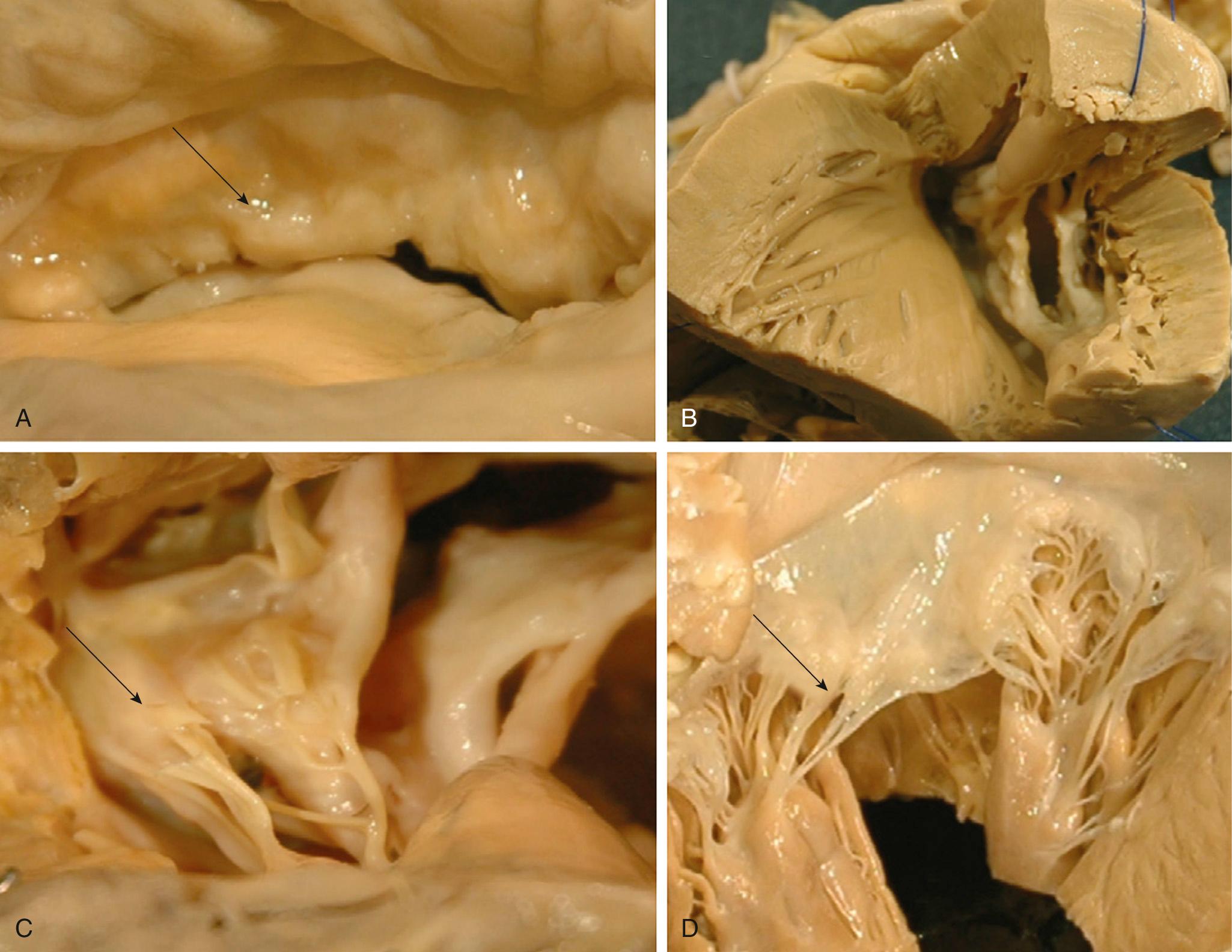
The diagnosis of mitral stenosis can be based on medical history, physical examination, electrocardiography, chest radiography, echocardiography, and invasive hemodynamics. As explained previously, patients are most often women and are frequently asymptomatic, although symptoms can include fatigue, dyspnea, hemoptysis (from rupture of dilated bronchial veins), new onset atrial fibrillation, or systemic thromboembolism.
Patients with chronic severe mitral stenosis are often cachectic because of longstanding low cardiac output. In the absence of left ventricular dysfunction, peripheral pulses are normal and the apical impulse is in the standard position on chest palpation. A right ventricular parasternal heave is present in the setting of pulmonary hypertension. Auscultatory findings include a loud S 1 , an opening snap, and a diastolic murmur. The diastolic murmur is a low-pitched rumble best heard at the apex. The early diastolic opening snap is generated by sudden tensing of the pliable leaflets during valve opening and is absent later in the disease when the leaflets are immobile. The electrocardiogram may be normal but often demonstrates P-wave abnormalities indicative of left atrial enlargement (biphasic P-wave in lead V 1 ; or broad, notched P-wave in lead II), atrial fibrillation, or right ventricular hypertrophy (right-axis deviation and a tall R-wave in lead V 1 ). The chest radiograph may be normal; however, a large left atrium is frequently seen. In patients with severe mitral stenosis and pulmonary hypertension, the right atrium and ventricle may also be enlarged.
Echocardiography has become the principle diagnostic method for assessing mitral valve disease. Echocardiography permits evaluation of the morphology, mobility, and extent of calcification of the mitral leaflets, commissures, and subvalvular apparatus. In addition, the severity of mitral stenosis can be assessed by measuring the mitral valve area, the transmitral gradient, left atrial size, and the pulmonary artery pressures (see Table 80-1 ). Transthoracic echocardiography also provides a noninvasive evaluation of other valves, as well as right and left ventricular function. Echocardiographic characteristics of the mitral valve apparatus are used to determine candidacy for percutaneous balloon valvuloplasty.
Left-sided heart catheterization is not usually necessary for diagnosis of mitral stenosis, but it can be useful when there is a discrepancy between data from noninvasive assessments. In patients that meet criteria for surgical intervention, cardiac catheterization should be performed to ascertain whether coronary artery disease is present. Right-sided heart catheterization is performed to measure the severity of pulmonary hypertension, and it can be used to determine reversibility after administration of pulmonary vasodilators.
Although the average age of index cases of rheumatic fever is approximately 12 years, symptoms do not generally become apparent until 30 years of age. Once symptoms develop, progression to incapacitating disability occurs over approximately 10 years, and those with more severe symptoms have poorer prognoses ( Fig. 80-5 ). As such, the development of symptoms is integral in the treatment decision-making process. In surgically untreated patients with mitral stenosis, the average age of death is between 40 and 50 years.
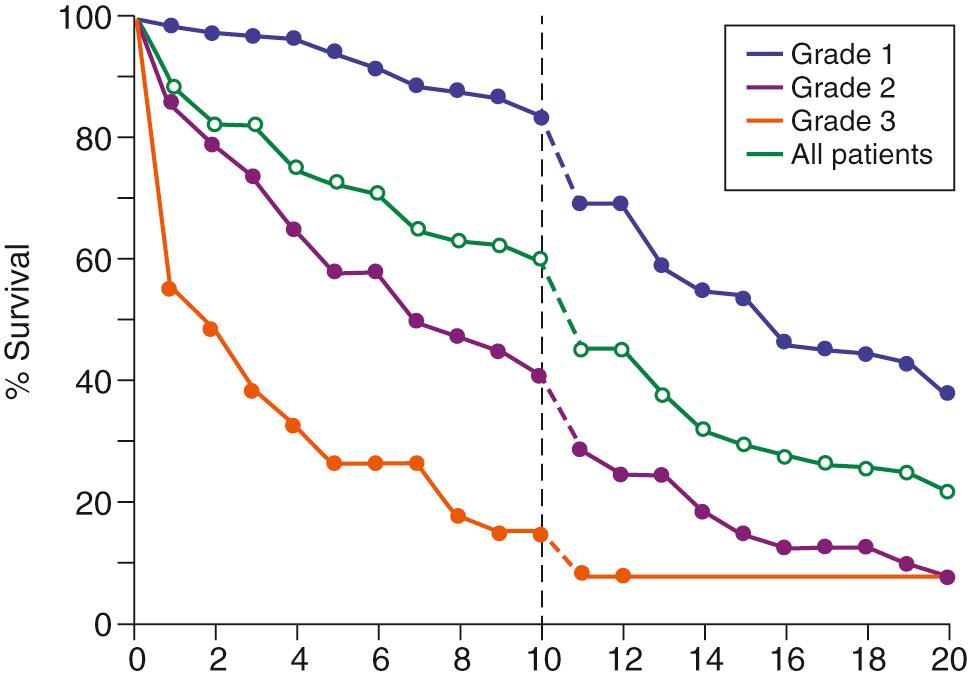
Various sequelae often develop during the course of surgically untreated mitral stenosis that shorten the interval between symptom onset and death. Left atrial hypertension ultimately distorts atrial cardiomyocyte architecture and predisposes patients to atrial fibrillation. The onset of atrial fibrillation often initiates symptoms because patients with mitral stenosis rely heavily on atrial contraction for ventricular filling, and rapid heart rates reduce the duration of diastole. Consequently, cardiac output declines and left atrial pressure rises. In fact, atrial fibrillation incrementally increases the risk of death in patients with surgically untreated mitral stenosis; 20-year survival was 10% in patients with atrial fibrillation compared with 29% in those in sinus rhythm.
Systemic thromboembolism also significantly alters the course of the disease, particularly when it results in stroke. Although most emboli originate in the left atrial appendage or left atrium, atrial fibrillation is not prerequisite for thrombus formation in surgically untreated mitral stenosis. Overall, arterial thromboembolization occurs in at least 10% of surgically untreated patients with mitral stenosis.
Pulmonary hemorrhage infrequently can develop in even mildly symptomatic patients, but the risk remits after surgical correction of the stenotic valve. Finally, infective endocarditis is uncommon in patients with mitral stenosis.
It is important to emphasize that these data and complicating events correspond to medically treated and surgically untreated patients with mitral stenosis. In fact, progression from initial symptoms to death was likely much shorter before medical therapies such as diuretics were developed. Similarly, surgical treatment has significantly altered the disease course. The increased life expectancy of such patients after surgical correction of mitral stenosis has resulted in the manifestation of late significant rheumatic aortic valve disease and late secondary tricuspid regurgitation.
Untreated mitral stenosis is associated with a poor prognosis once severe symptoms occur. Percutaneous balloon mitral commissurotomy is the first-line therapy for mitral stenosis in patients with favorable anatomy. This procedure is indicated in symptomatic patients (stage D) with isolated severe mitral stenosis (mitral valve area ≤1.5 cm 2 ; Fig. 80-6 ). Left atrial thrombus and greater than mild mitral regurgitation are contraindications to balloon commissurotomy. Percutaneous balloon commissurotomy may also be appropriate in asymptomatic patients with severe mitral stenosis (valve area <1.0 cm 2 ) and in those with severe mitral stenosis and new onset atrial fibrillation. Finally, balloon commissurotomy can be considered in symptomatic individuals with mitral valve area greater than 1.5 cm 2 if there is hemodynamic evidence of significant mitral stenosis with exercise (e.g., pulmonary capillary wedge pressure > 25 mm Hg). The Wilkins scoring system grades mitral valve morphology by use of echocardiography ( Table 80-2 ). Four characteristics, graded on a scale from 0 to 4, are assessed: leaflet mobility, leaflet thickening, valve calcification, and extent of subvalvular disease. A total score greater than 8 is predictive of low success with percutaneous balloon mitral commissurotomy. Percutaneous balloon commissurotomy is associated with recurrent mitral stenosis, especially in patients undergoing repeat procedures for recurrence, as well as iatrogenic mitral regurgitation, particularly in patients with high Wilkins scores.
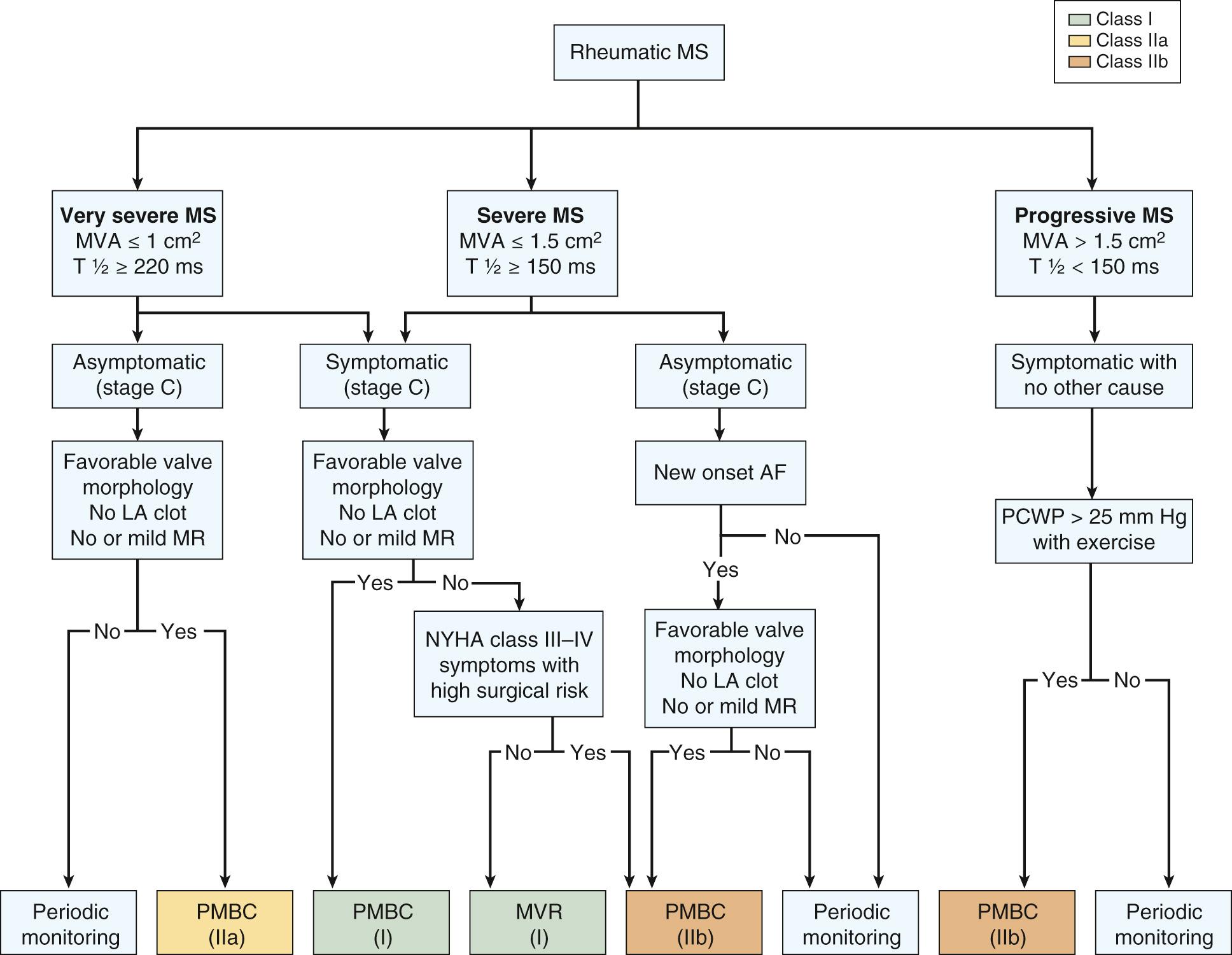
| Grade | Mobility | Thickening | Calcification | Subvalvular Thickening |
|---|---|---|---|---|
| 1 | Highly mobile valve with only leaflet tips restricted | Minimal leaflet thickening (4-5 mm) | Single area of increased echo brightness | Minimal thickening just below the mitral leaflets |
| 2 | Leaflet mid and base portions have normal mobility | Midleaflets normal, considerable marginal thickening (5-8 mm) | Scattered areas of brightness confined to leaflet margins | Thickening of chordal structures extending to one-third the chordal length |
| 3 | Valve continues to move forward in diastole, mainly from the base | Entire leaflet thickened (5-8 mm) | Brightness extends into mid-portion of leaflets | Thickening extended to distal third of the chords |
| 4 | No or minimal forward movement of the leaflets in diastole | Considerable thickening of entire leaflet (>8-10 mm) | Extensive brightness throughout much of the leaflet tissue | Extensive thickening and shortening of all chordal structures that extends to the papillary muscles |
Mitral valve surgery is an established therapy for mitral stenosis that predates balloon commissurotomy. Surgical options include commissurotomy (either closed or open, the latter permitting more extensive surgery under direct visualization) or mitral valve replacement. Because of the insidious nature of mitral stenosis and evidence that mitral stenosis does not have longstanding detrimental effects on the left ventricle, surgery should be delayed until the patient has severe, limiting symptoms (New York Heart Association [NYHA] class III or IV). Thus, mitral valve surgery is indicated in severely symptomatic patients (NYHA class III or IV) with severe mitral stenosis (mitral valve area ≤ 1.5 cm 2 ) who are not high risk for surgery and who are not candidates for or who have failed previous percutaneous balloon mitral commissurotomy (see Fig. 80-6 ). Concomitant mitral valve surgery is also recommended in patients with severe mitral stenosis undergoing cardiac surgery for other primary indications.
Mitral regurgitation, the retrograde ejection of blood from the left ventricle into the left atrium during systole, may be acute, chronic and compensated, or chronic and decompensated. The new low resistance, regurgitant pathway results in volume overload of the left ventricle at end diastole (increased preload) as well as in a reduction of afterload. Subsequently, a larger volume of blood is ejected from the left ventricle with each contraction. However, the effective forward stroke volume and cardiac output actually decrease because a proportion of the blood volume is ejected retrograde into the left atrium. Volume overload in the left atrium increases left atrial pressure from a normal level of approximately 10 mm Hg to as high as 25 mm Hg. The increased preload ultimately induces ventricular remodeling through eccentric hypertrophy and dilation. A larger ventricular cavity allows for an increase in total stroke volume, thereby maintaining forward stroke volume at near normal levels. This is chronic compensated mitral regurgitation.
Because the annulus is continuous with the left ventricle, annular dilation results from ventricular enlargement. The normal ratio between the anteroposterior and transverse diameters of the mitral annulus is 3:4 in systole. In chronic mitral regurgitation, this ratio is inverted, impairing proper leaflet coaptation and generating regurgitant flow even in the absence of leaflet prolapse. Annular dilation affects the posterior annulus to a greater extent than the anterior annulus.
Similar to ventricular compensation via enlargement, the left atrium dilates to accommodate the volume overload at lower filling pressures. Atrial enlargement increases the risk of atrial arrhythmias, such as atrial fibrillation and consequent mural thrombi from stasis. When mitral regurgitation develops suddenly from chordal rupture, papillary muscle infarction, or leaflet perforation, there is inadequate time for left atrial and ventricular compensation. Thus, patients with acute mitral regurgitation typically present in a state of acute pulmonary edema and cardiogenic shock.
Ultimately, volume overload and eccentric ventricular hypertrophy impair ventricular performance and prevent effective ventricular contraction; this is chronic decompensated mitral regurgitation. Stroke volume and cardiac output decline as blood preferentially flows retrograde into the lower resistance pathway. Consequently, the pressure in the left atrium and pulmonary vasculature increases. Untreated decompensated mitral regurgitation progresses to irreversible pulmonary hypertension, pulmonary edema, and congestive heart failure. The presence of left ventricular dysfunction portends a worse prognosis regardless of the treatment modality. Although ventricular reverse remodeling can follow surgical correction of mitral regurgitation, it remains evident that normalization of cardiac dimensions is less likely or impossible once the ventricle has enlarged to a certain extent.
A thorough description of valve disease should incorporate the pathophysiologic triad first proposed by Carpentier ( Table 80-3 ). The triad includes etiology (cause of the disease), valve lesions (structural changes resulting from the disease process), and leaflet dysfunction (alterations in leaflet motion resulting from the structural lesion). This classification scheme is emphasized because prognosis is etiology dependent, treatment strategy is determined by the type of valve dysfunction, and different surgical techniques are selected for specific valve lesions.
| Dysfunction | Lesions | Etiology |
|---|---|---|
| Type I | ||
| Normal leaflet motion | Annular dilation |
|
| Leaflet perforation | Endocarditis | |
| Type II | ||
| Increased leaflet motion above annular plane (leaflet prolapse) | Chordal elongation or rupture |
|
| Papillary muscle elongation or rupture |
|
|
| Type IIIa | ||
| Restricted leaflet motion (systole and diastole) |
|
|
| Type IIIb | ||
| Restricted leaflet motion (systole only) |
|
|
The mechanism of mitral regurgitation can be categorized using Carpentier's functional classification ( Fig. 80-7 ). The classification system is compartmentalized according to variations in leaflet motion. In type I dysfunction, leaflet motion is normal and a central mitral regurgitation jet is generated by annular dilation or leaflet perforation. Type II dysfunction describes leaflet prolapse, where the free margin of one or both leaflets rises above the annular plane in systole. Such leaflet dysfunction is most commonly due to chordal elongation or rupture, followed by papillary muscle elongation and rupture. In type III dysfunction leaflet motion is restricted. Leaflet motion restricted during both diastole and systole is classified as type IIIa. Lesions commonly associated with rheumatic valvulitis are most often responsible for type IIIa dysfunction, including (1) leaflet thickening and retraction; (2) chordal thickening, shortening, or fusion; and (3) commissural fusion. As such, coexistent mitral stenosis is not uncommon in the setting of type IIIa mitral regurgitation. Type IIIb dysfunction describes leaflet motion restricted only during systole. Such dysfunction is the result of left ventricular dilation and subsequent leaflet tethering from papillary muscle displacement.
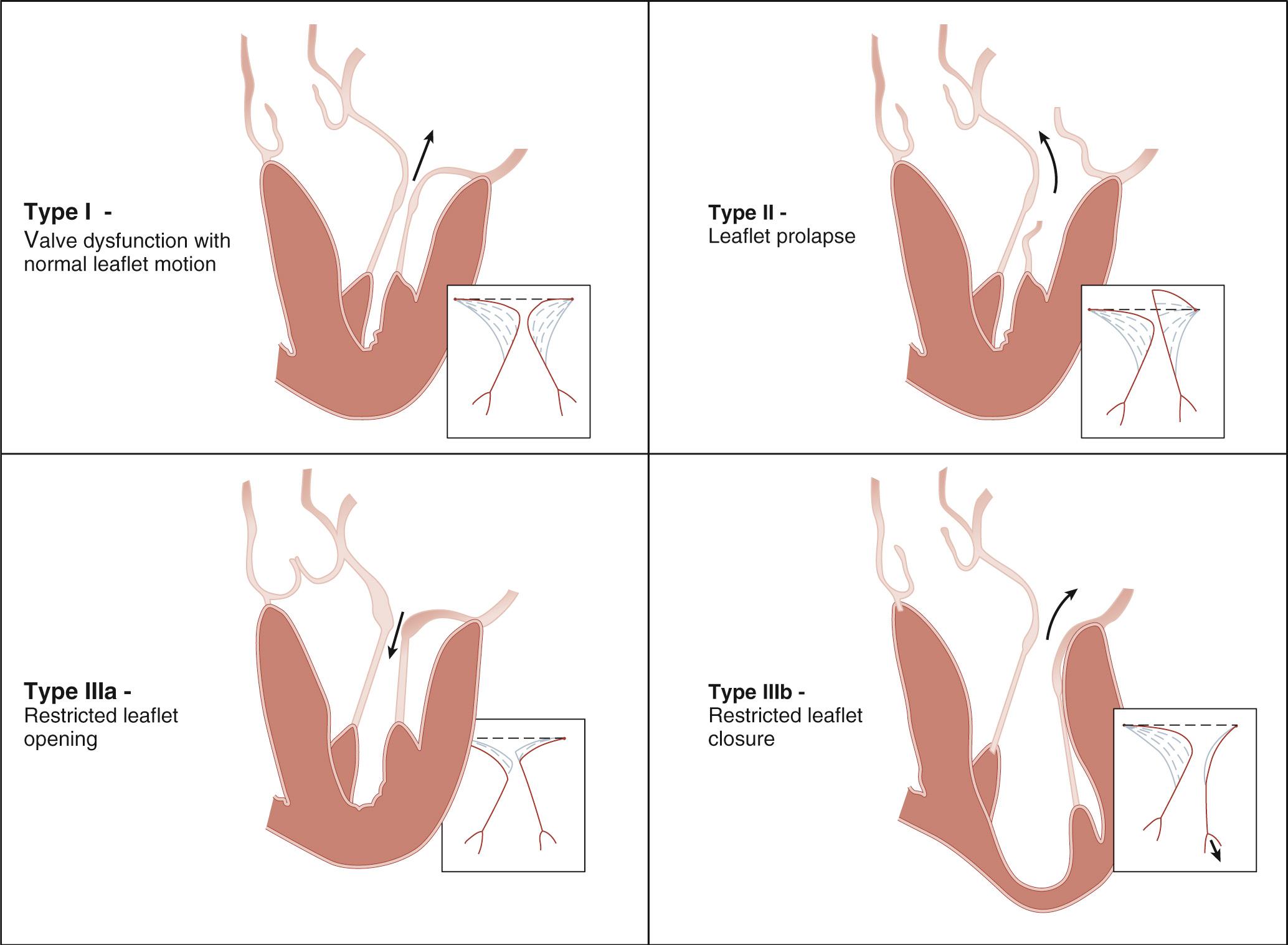
Systolic prolapse of a mitral valve leaflet is a relatively common and complex disease process. When severe, mitral prolapse begets significant mitral regurgitation, albeit infrequently (about 10% of patients). Nevertheless, degenerative mitral valve disease is the most common cause of isolated mitral regurgitation in the United States. Pathologic examination of degenerative mitral valves reveals mitral leaflet redundancy and myxomatous leaflet thickening that typically result from collagen replacement by acid mucopolysaccharides. Mutual support is lost as redundant and elongated leaflets improperly coapt during systole. Consequently, the leaflets extend into the left atrium and the valve is rendered regurgitant. Simultaneously, chordae are placed under abnormal strain. The chordae elongate and may ultimately rupture, generating more regurgitation. Annular dilation and calcification can also arise to varying extents and further contribute to the complexity of the mitral valve dysfunction.
The spectrum of degenerative mitral valve disease is often subclassified into fibroelastic deficiency and Barlow's disease. In fibroelastic deficiency, or idiopathic chordal rupture, a considerable portion of leaflet tissue is unaffected by the myxomatous transformation ( Fig. 80-8 ). Typically, regurgitation is caused by rupture of a single chord that supports the posteromedial portion of the posterior leaflet (P2). Following rupture, the less supported leaflet segment becomes redundant and flail. More extensive posterior chordal rupture may sometimes occur. Patients with fibroelastic deficiency are characteristically older with a short history of mitral regurgitation.
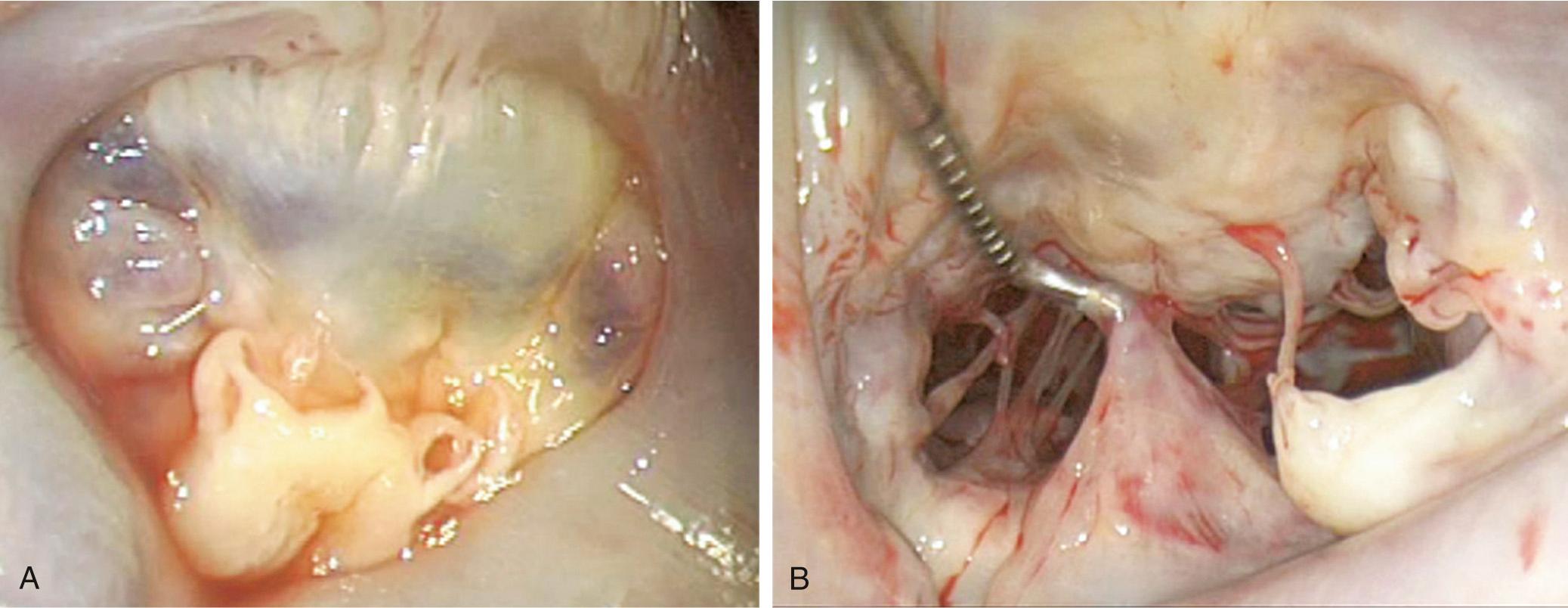
On the opposite end of the degenerative mitral valve disease spectrum, Barlow's disease presents early in life, and most patients have a long history of a systolic murmur. Barlow's disease is characterized by extensive excess leaflet tissue in a dilated annulus ( Fig. 80-9 ). Leaflet tissue is thickened, and there is marked redundancy in multiple segments. In addition, chordae and occasionally papillary muscles are thickened and elongated. Regurgitation is complex and secondary to multisegment leaflet prolapse. Forme fruste valves share morphologic features of Barlow's disease and fibroelastic deficiency: multisegment thickening and prolapse within a smaller valve.
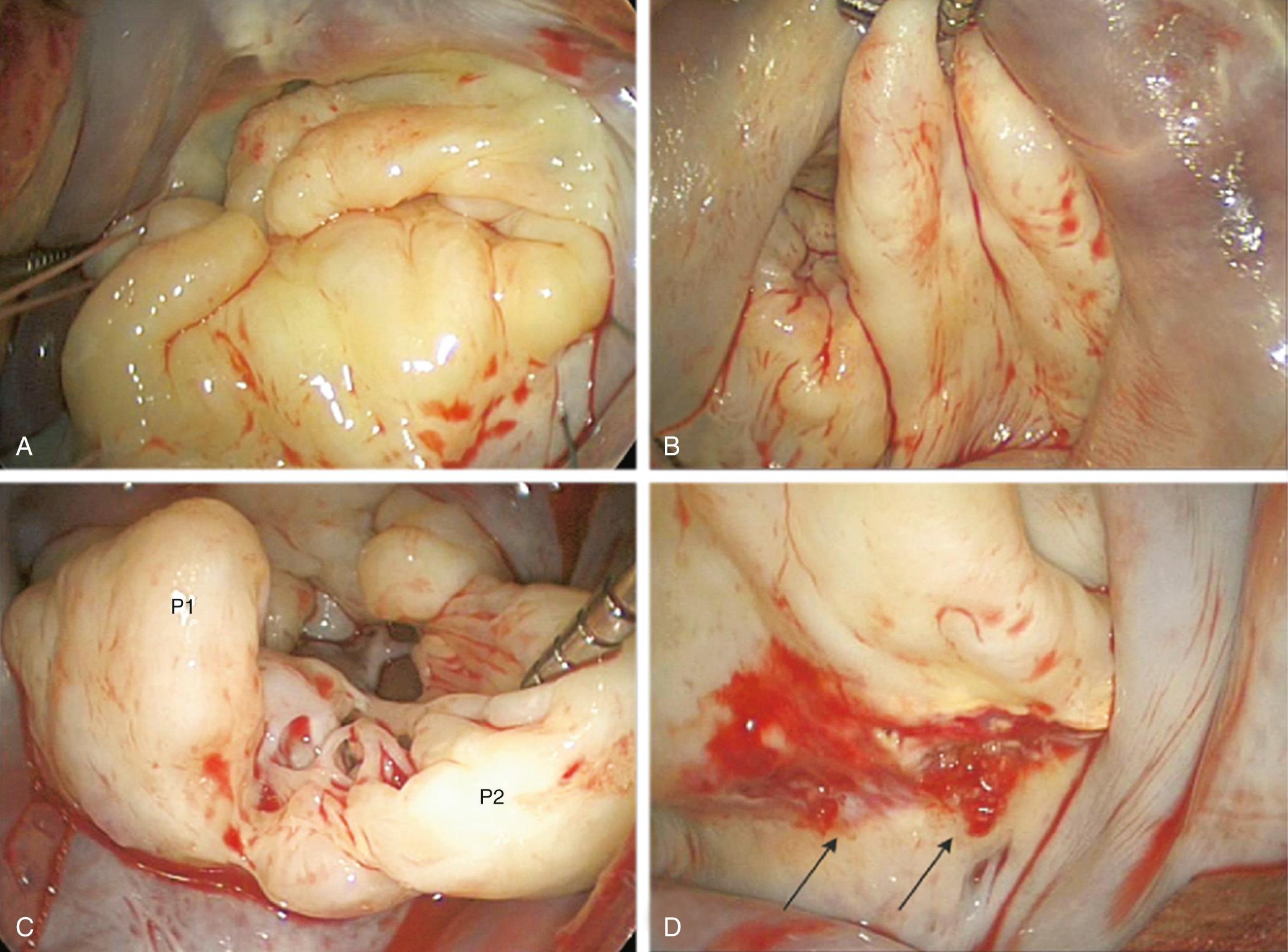
Progressive leaflet thickening and retraction, as well as chordal shortening and fusion from chronic valvulitis restrict leaflet motion during both diastole and systole, thereby rendering the valve regurgitant (see Fig. 80-4 ). The anterior leaflet is typically less thickened, and particularly in younger patients, elongated major chordae may allow regurgitation from anterior leaflet prolapse. Annular dilation from extensive myocarditis may cause transient mitral regurgitation in the acute rheumatic process. This mitral regurgitation can spontaneously regress after remission of the pancarditic acute rheumatic process.
Annular calcification is most often seen in older people. Although it can occur without apparent disease of the leaflets or chordae, it may be more common in patients with myxomatous degeneration of the mitral leaflets. Calcifying disease of the annulus is a degenerative process that usually involves the posterior circumference of the annulus more than other portions. Annular calcification can extend into the adjacent myocardium of the left ventricle, and it yields mitral regurgitation through restricted motion of the posterior leaflet. Such calcification can substantially complicate mitral repair or replacement.
Endocarditis is a relatively uncommon cause of isolated mitral regurgitation compared with the frequency in which it is accountable for aortic regurgitation. Mitral valve endocarditis typically occurs in patients with an already structurally abnormal valve because of underlying degenerative or rheumatic valve disease. However, several virulent organisms, such as Staphylococcus aureus , may infect nondiseased valves. Staphylococci and Streptococci now account for 80% of cases of endocarditis. Upon infection of a normal or abnormal mitral valve, mitral regurgitation can result from destruction of leaflet cusps, chordae, or both. Because of their spatial interrelatedness, aortic valve endocarditis may directly extend to the mitral valve as vegetations may drop down onto and infect the central portion of the anterior leaflet of the mitral valve ( Fig. 80-10 ).
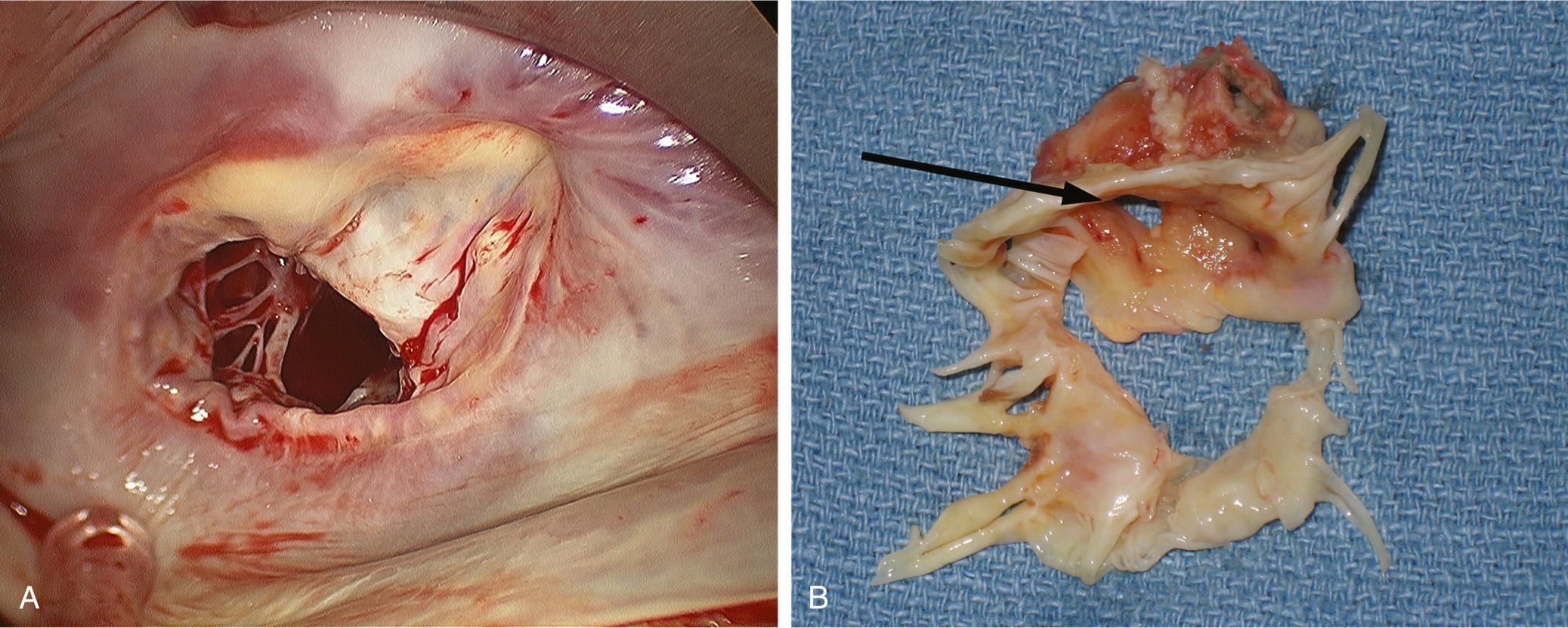
Left ventricular remodeling after myocardial infarction results in a conversion of the ventricular shape from ellipsoidal to spherical. Consequently, the papillary muscles are displaced, leading to restriction or tethering of posterior leaflet motion during systole (see Fig. 80-10 ). Leaflet coaptation surface area is compromised, resulting in mitral regurgitation. Furthermore, because of structural continuity between the ventricle and annulus, ventricular dilation leads to annular dilation that may exacerbate mitral regurgitation. Acute mitral regurgitation can result from ischemic papillary muscle dysfunction or rupture. Occasionally, the papillary muscle will not rupture, but will become fibrotic and subsequently elongate, leading to leaflet prolapse.
The etiology of this disease is frequently idiopathic; however, known causes include chronic atrial fibrillation, myocarditis, excessive alcohol consumption, and immunologic abnormalities. Similar to ischemic cardiomyopathy, the natural history of the disease is often complicated by functional mitral regurgitation secondary to ventricular remodeling.
Submitral ventricular aneurysms can also result in mitral regurgitation. Such an aneurysm is not due to myocardial ischemia, and it occurs almost exclusively in Africa. The aneurysm is generally situated directly beneath the posterior mitral leaflet; therefore, mitral regurgitation develops from aneurysmal distortion of the posterior leaflet.
Patients with chronic mitral regurgitation are often asymptomatic for years. During this time, left ventricular size can gradually increase and myocardial contractility declines. Ultimately, patients develop exercise intolerance and symptoms consistent with pulmonary venous hypertension. Fluid retention, chronic cardiac failure, and occasionally cardiac cachexia are representative of longstanding untreated disease. Coexistent secondary tricuspid regurgitation is frequently apparent at such late stages of the disease.
Similar to mitral stenosis, significant mitral regurgitation can generally be diagnosed on the basis of history, physical examination, electrocardiogram, and chest radiograph. On auscultation, a classic pansystolic murmur is appreciable, loudest at the apex, and radiates to the left axilla. However, murmurs may be heard in the parasternal aortic area or infrascapular–posterior cervical area in the setting of eccentric jets from posterior leaflet or anterior leaflet prolapse, respectively. An S 3 may be present because of augmented transmitral flow from volume overload and left ventricular dilation. In addition, lateral displacement of the left ventricular apical impulse from ventricular dilation and parasternal lift from elevated pulmonary arterial pressures indicate more severe disease.
The electrocardiogram may remain unremarkable despite severe mitral regurgitation; however, evidence of ventricular hypertrophy or left atrial enlargement may also be present. Chest radiography in severe chronic mitral regurgitation may demonstrate left atrial and ventricular dilation (typically greater than in patients with mitral stenosis), and prominent pulmonary vasculature suggests the presence of pulmonary hypertension.
Two-dimensional echocardiography via transthoracic and transesophageal approaches delineate the mechanism and severity of mitral regurgitation ( Table 80-4 ; Fig. 80-11 ). Echocardiography can also be used to assess left ventricular dimensions and global and regional contractility. Three-dimensional echocardiographic imaging techniques clearly identify leaflet pathology and specific areas of regurgitation within the mitral valve. Novel magnetic resonance imaging techniques also accurately characterize anatomic and functional details of mitral valve dysfunction.
| Mild | Moderate | Severe | ||
|---|---|---|---|---|
| Specific Signs of Severity | Signs of MR > mild present, but no criteria for severe MR | |||
| Supportive Signs of Severity | Intermediate signs and findings | |||
| Quantitative Parameters ¶ | ||||
| R Vol (mL/beat) | <30 | 30-44 | 45-59 | ≥60 |
| RF (%) | <30 | 30-39 | 40-49 | ≥50 |
| EROA (cm 2 ) | <0.20 | 0.20-0.29 | 0.30-0.39 | ≥0.40 |
* At a Nyquist limit of 50-60 cm/sec.
† Minimal and large flow convergence radius <0.4 cm and ≤0.9 cm for central jets, respectively, with a baseline shift at a Nyquist of 40 cm/sec. Cutoffs for eccentric jets are higher and should be angle corrected.
‡ Usually above 50 years of age or in conditions of impaired relaxation, in the absence of mitral stenosis or other causes of elevated LA pressure.
§ LV size applied only to chronic lesions.
‖ In the absence of other etiologies of LV and LA dilation and acute MR.
¶ Quantitative parameters can help to subclassify the moderate regurgitation group into mild-to-moderate and moderate-to-severe as shown.
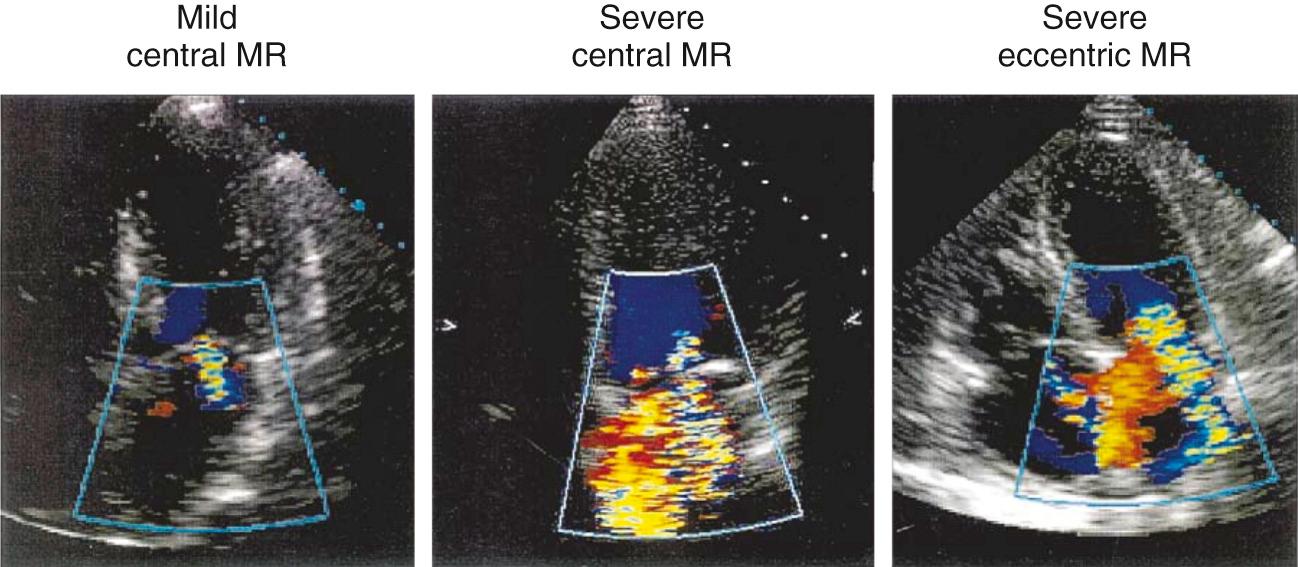
Mitral regurgitation can be characterized by left ventriculography. Leaflet prolapse can be visualized, and the degree of regurgitation can be estimated. Quantitative ventriculography permits calculation of regurgitant flow and left ventricular stroke volume, and forward flow can be assessed through measurement of cardiac output. Furthermore, left heart catheterization is particularly useful to discern the extent of coronary artery disease, if present.
Mitral regurgitation can develop acutely because of chordal rupture or infective endocarditis or early in the evolution of acute myocardial infarction. Symptoms and signs are consistent with acute elevation of pulmonary venous pressures and low cardiac output. On auscultation, the murmur of mitral regurgitation is often midsystolic and higher pitched compared with the classic pansystolic murmur of chronic mitral regurgitation. The left atrium and left ventricle are normal in size because of inadequate time for compensation through dilation. Because of acute elevation of pulmonary venous pressure, significant pulmonary edema is often noted on chest radiography.
Defining the natural history of mitral regurgitation is problematic because the disease etiology varies, age at onset varies, mitral regurgitation may not worsen for many years, and left ventricular function declines at different rates. It is important to note that left ventricular contractility is not truly assessed by ejection fraction. In fact, in the setting of mitral regurgitation, ventricular contractility often declines despite normal systolic function (ejection fraction) because part of the stroke volume is ejected retrograde into the low pressure left atrium. Ejection fraction does not actually decrease until later in the disease process. Patients with mitral regurgitation can also develop secondary tricuspid regurgitation, which also affects natural history.
Degenerative disease, the most common organic mitral valve disease in the United States, occurs in approximately 2% to 3% of adults. However, many patients do not progress to developing significant regurgitation requiring intervention. In fact, severe mitral regurgitation requiring valve repair or replacement is uncommon before the age of 50. Although the prevalence increases steeply thereafter, persons with mitral valve prolapse who reach age 70 still only have about a 5% chance of requiring mitral valve surgery. Nevertheless, once significant mitral regurgitation develops, the disease progresses similarly to those with ruptured chordae and flail leaflets.
Once a diagnosis of flail leaflet is made, medical management typically is inadequate in improving patient symptoms and survival. Patients with surgically untreated mitral regurgitation because of flail leaflet have mortality rates significantly higher than expected (6.3% yearly). Severe symptoms portend a worse prognosis as patients even transiently in NYHA class III or IV have much higher mortality rates (34% yearly), although the rate is notable even among those in NYHA class I or II (4% yearly). Essentially, surgery is almost unavoidable within 10 years after the diagnosis and is associated with an improved prognosis in patients with degenerative disease.
The natural history of ischemic mitral regurgitation is covered in Chapter 92 . Because ischemic mitral regurgitation is a manifestation of a ventricular disease, it is not surprising that these patients typically have a significantly worse survival than those with degenerative disease.
Patients with surgically untreated but significant rheumatic mitral regurgitation demonstrate survival similar to those with rheumatic mitral stenosis. Likewise, the survival curves are considerably shorter in particular geographic areas and in certain races: 5-year survival after initial evaluation for rheumatic mitral regurgitation in the United States was 80% compared with 46% in Venezuela.
Infection of a previously mildly abnormal mitral valve can generate acute mitral regurgitation. The natural history of such a condition is similar to that of mitral regurgitation caused by chordal rupture. However, the early mortality is significantly higher as death can occur from overwhelming infection and sepsis.
Intervention for patients with primary mitral regurgitation consists of either surgical mitral valve repair or replacement. Mitral valve repair is preferred over replacement if a successful and durable repair can be achieved. Reparability is dependent on valve morphology and surgeon expertise.
Acute severe mitral regurgitation is an indication for urgent surgery. The indications for surgery in chronic severe mitral regurgitation have evolved during the last decade to reflect incremental improvements in the safety and efficacy of mitral valve repair as well as a better understanding of long-term outcomes in surgically untreated patients. Recommendations by the ACC/AHA for surgical intervention are predicated on symptoms, left ventricular dysfunction, atrial fibrillation, pulmonary hypertension, and valve reparability ( Fig. 80-12 ).
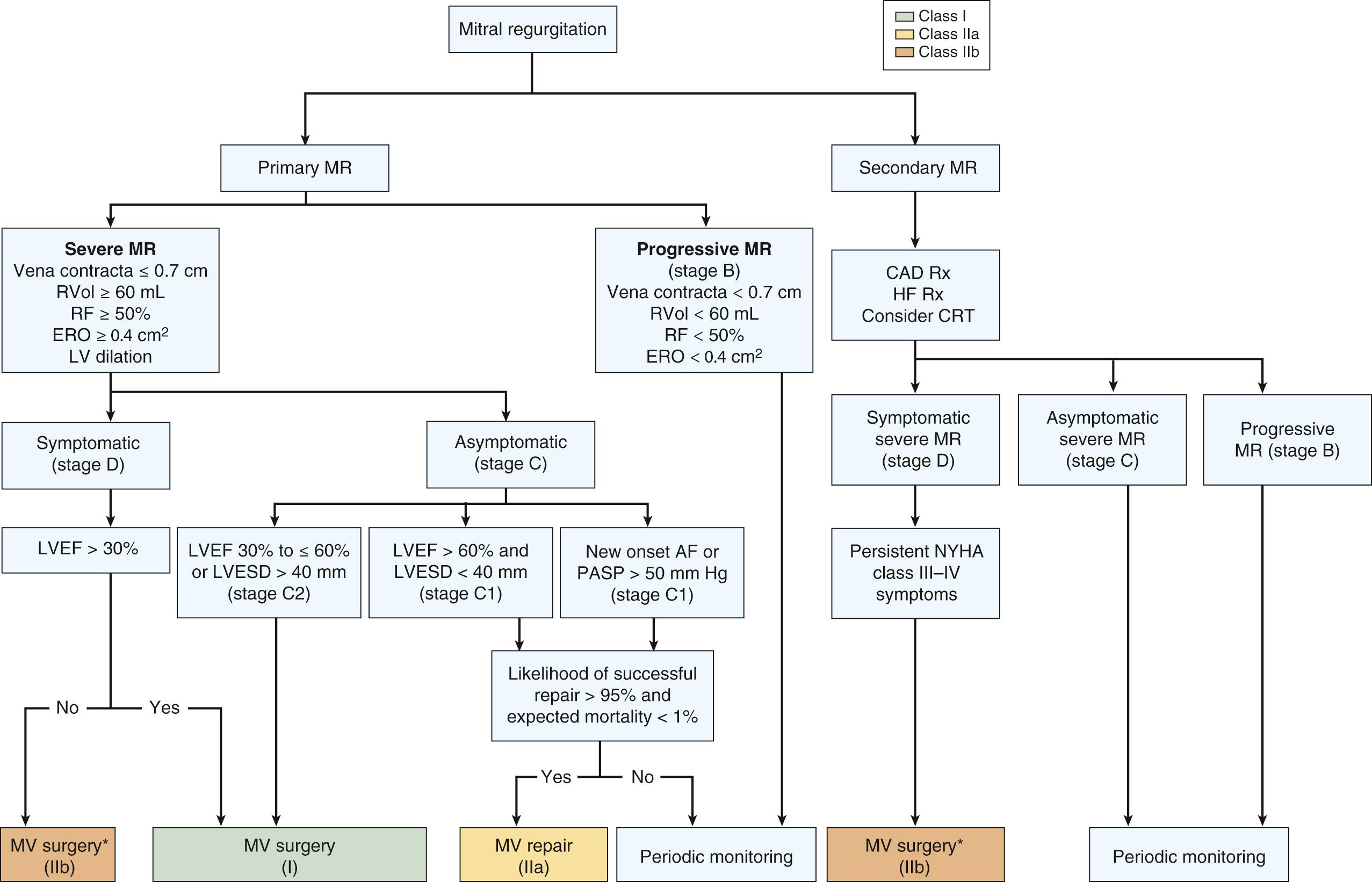
The onset of symptoms that results from severe mitral regurgitation worsens prognosis even when left ventricular function appears to be normal. This negative prognostic effect extends even to mild symptoms. Thus, an increasing number of clinicians advocate operating earlier in less-symptomatic patients because NYHA functional class has been shown to be an independent predictor of postoperative mortality and left ventricular dysfunction. Postoperative long-term survival is higher in patients in NYHA class I or II before surgery compared with those in class III or IV, (at 10 years, 76% vs. 48%), and operative mortality is lower (0.5% vs. 5.4%; Fig. 80-13 ).
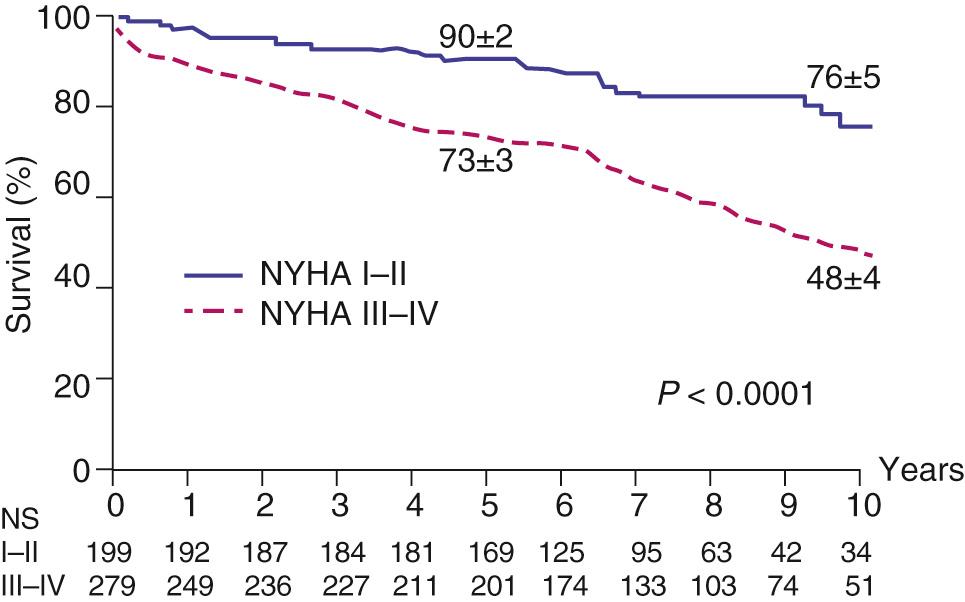
Preoperative left ventricular dysfunction, as assessed by ejection fraction and end-systolic dimension, is one of the strongest predictors of survival, postoperative ventricular function, and functional status after surgery for chronic primary mitral regurgitation. Specifically, it has been reported that when the ejection fraction falls below 60%, mortality increases precipitously and prompt surgical referral is critical to outcome ( Fig. 80-14 ). Thus, the goal of therapy in mitral regurgitation is to correct it before the onset of left ventricular systolic dysfunction and the subsequent adverse effect on patient outcomes. Ideally, mitral valve surgery should be performed when the patient's left ventricle approaches but has not yet reached the parameters that indicate systolic dysfunction (left ventricular ejection fraction [LVEF] ≤ 60% or left ventricular end-systolic dimension [LVESD] ≥ 40 mm), even if the patient is asymptomatic. Because symptoms do not always coincide with left ventricular dysfunction, imaging surveillance is used to plan surgery before ventricular function has severely deteriorated. Further delay, even though symptoms are absent, will lead to greater left ventricular dysfunction and an even worse prognosis. Although it is inadvisable to allow patients' left ventricular function to deteriorate beyond the benchmarks of an LVEF ≤ 60% and/or LVESD ≥ 40 mm, some recovery of left ventricular function can still occur even if these thresholds have been crossed.
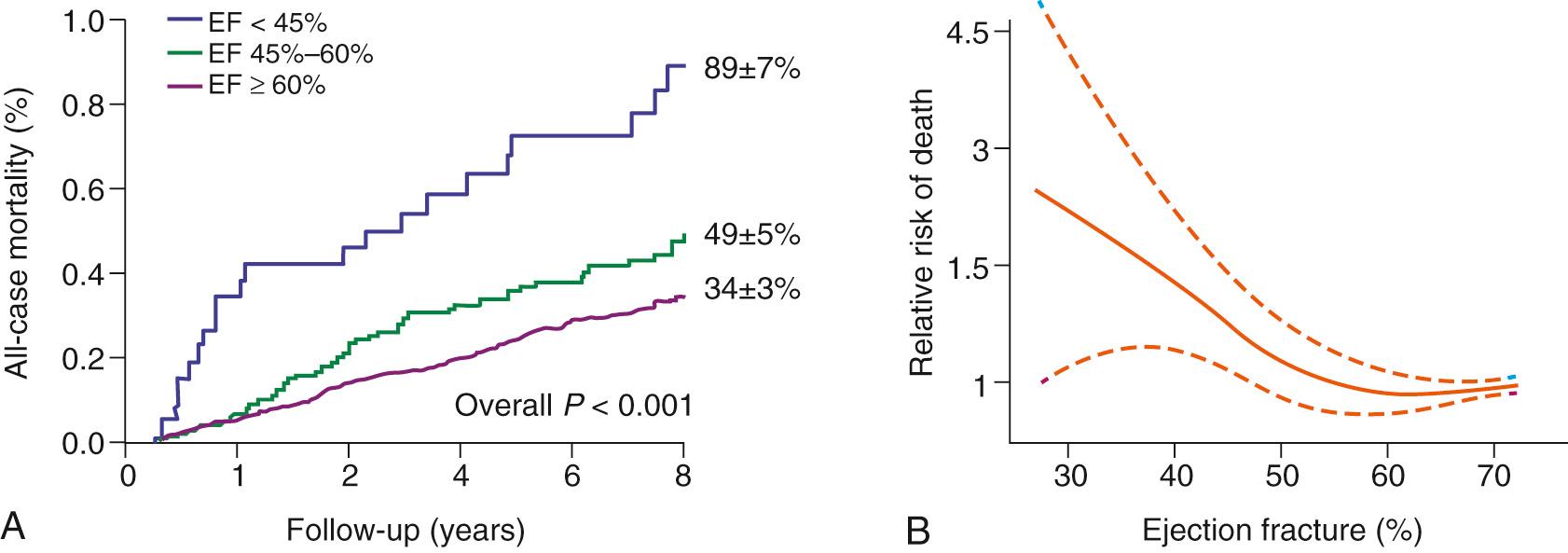
In nonrheumatic mitral regurgitation, the onset of atrial fibrillation is in part due to enlarging left atrial size, and its presence worsens surgical outcome. Furthermore, the longer atrial fibrillation is present, the more likely it is to persist despite intervention. Therefore, it may be reasonable to restore mitral competence by low-risk repair with the hope that the ensuing reduction in left atrial size will help restore and maintain sinus rhythm. The ACC/AHA guidelines advocate surgery in asymptomatic patients with severe mitral regurgitation and new onset atrial fibrillation. However, restoration of sinus rhythm following valve surgery is uncertain, and concomitant surgical ablation of atrial fibrillation should be a standard adjunct to patients with a history atrial arrhythmia. This strategy does not apply to rheumatic mitral regurgitation, in which active atrial inflammation can make restoration of sinus rhythm less likely and valve scarring reduces the likelihood of a successful repair. The presence of resting pulmonary arterial hypertension caused by mitral regurgitation is associated with poorer operative and long-term survival after valve surgery. Thus, it is reasonable to consider surgery in these asymptomatic patients if resting pulmonary artery systolic pressure exceeds 50 mm Hg and if there is a high likelihood of a successful and durable repair.
Mitral valve repair is preferred over replacement if a successful and durable repair can be achieved. Mitral valve repair is performed at a lower operative mortality rate than replacement. Although no randomized trials exist for degenerative mitral valve disease, nearly every clinical report has demonstrated that operative risk for repair is approximately half that of replacement. Valve repair not only avoids the risks inherent to prosthetic heart valves, but it better preserves left ventricular function by preserving the subvalvular apparatus. In the case of posterior leaflet prolapse, repair has become sufficiently standardized so that repair is the standard of care. The ACC/AHA guidelines recommend that a successful repair rate of 90% or greater be the expectation of every cardiac surgeon who performs mitral valve procedures. Because the probability of successful mitral valve repair is strongly influenced by surgeon-specific mitral procedure volume, it is recommended that more complex valves be referred to heart teams with particular expertise in this area.
Standard monitoring lines are used if the procedure is performed through a median sternotomy. A pulmonary artery catheter should be placed in cases of complex mitral valve surgery and multivalve surgery, as well as in high-risk operative candidates. Carbon dioxide insufflation is routinely used to facilitate deairing and reduce the risk of air embolism following aortic cross-clamp removal. A thorough transesophageal echocardiography study should routinely be performed before the initiation of cardiopulmonary bypass to characterize the mechanism and severity of mitral regurgitation, as well as other valve lesions. Transesophageal echocardiography also permits assessment of left ventricular function, quality of the repair, and extent of deairing. External defibrillator and cardioversion pads are placed in patients undergoing reoperative surgery.
If a right minithoracotomy is planned, the anesthesiologist should place a double-lumen endotracheal tube to permit left lung ventilation and right lung deflation. External defibrillator pads are placed under the right scapula and over the left anterolateral chest. If an endoaortic balloon occlusion catheter will be used, bilateral radial arterial lines can be placed to facilitate rapid detection of balloon distal migration and innominate artery obstruction. Inadvertent balloon migration is not uncommon, and vascular injuries including aortic dissection have contributed to decreased utilization of this approach. Our institution prefers a transthoracic Chitwood aortic cross clamp and standard antegrade cardioplegia, retrograde cardioplegia, and right superior pulmonary vein venting cannulae placed across the chest wall or directly through the working incision. Thoracic epidural placement is not commonly used, because pain is reportedly mild after minithoracotomy incisions, particularly if rib spreading is avoided.
Become a Clinical Tree membership for Full access and enjoy Unlimited articles
If you are a member. Log in here